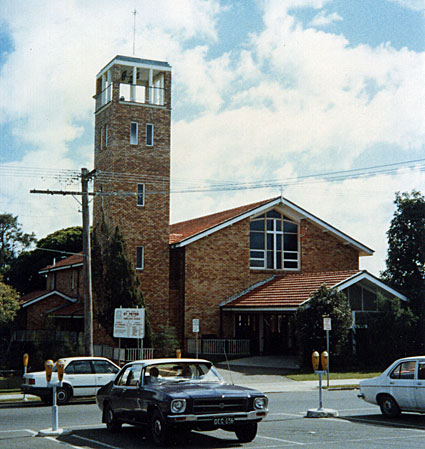
St Peter's Anglican Church, Southport
[Photograph by Howard Baker (c.1989)]

St Peter's Anglican Church, Southport
[Photograph by Howard Baker (c.1989)]
Historical and Technical Documentation by Geoffrey Cox
© OHTA 2011, 2012, 2016 (last updated January 2016)
The present St Peter's Anglican Church, Southport, was built in 1959, and dedicated on 26 June 1960. It replaced an earlier wooden church facing High Street, which had been opened in June 1887.1 The designs for the 1887 church had been provided by the short-lived architectural partnership, Banks and Carandini.2
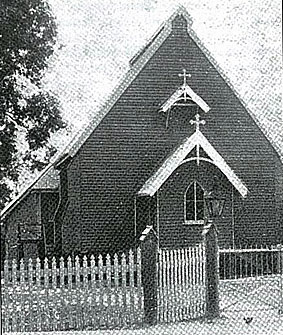
The earlier St Peter's Church of England, Southport
[Photograph: John Oxley Library, State Library of Queensland]
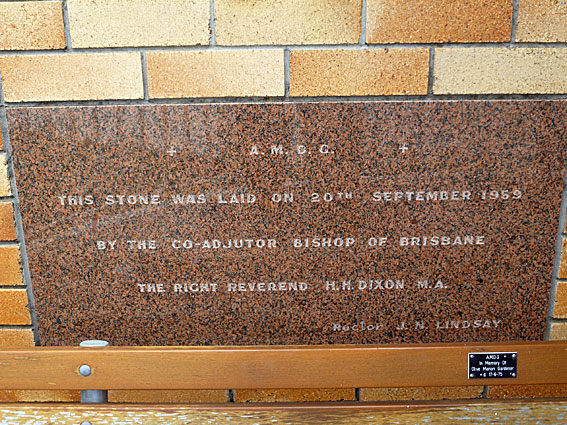
Foundation stone of the present St Peter's Church
[Photograph by David Vann (November 2012)]
The organ now in St Peter's Church was formerly in the chapel of The Southport School, where it was installed at the time the chapel was built around the end of 1921 or the beginning of 1922.3 Beyond this its origins are obscure, although it was rumoured at one time to have come from St Mary's Catholic Church, Ipswich. If it came from Ipswich, however, it is most likely that it was from St Stephen's Presbyterian Church, Ipswich, where the original organ installed in 1866 was replaced in 1916.
The organ was moved at the end of 1924 from the Southport School to the former St Peter's Church, and installed in the present church in 1959.4

Casework and façade pipes (central flat non-speaking)
[Photograph by Howard Baker, c.1989]
Until the mid 1970s, it had the following specification, with the pipework for the two manuals on a common chest:
| GREAT Diapason Diapason Bass Flute [Treble] Principal Fifteenth SWELL [unenclosed] Dulciana [Gemshorn] PEDAL Bourdon COUPLERS Swell to Great Bass Coupler |
8 8 8 4 2 8 4 16 |
} }[divided stop] [gvd bass from Great] [unlabelled] [Ten. C] [Great to Pedal] |
Draw-stop console
Compass: 54/30
Mechanical action.5
The instrument was rebuilt by Walter Emerson of Toowoomba in 1975-76 with electro-pneumatic action using Kegellade (cone-valve) chests, and a new detached console. The Dulciana 8ft and Flute 8ft were swapped between the two manuals at this time, and a Sifflute 1-1/3ft was added on the second manual in 1982.6 Emerson also increased the manual compass to 61 notes, and completed the basses of the Dulciana 8ft (from Tenor f down) and Gemshorn 4ft (bottom octave).7
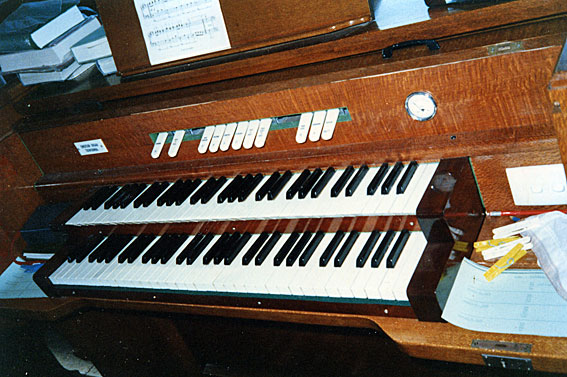
Detached console supplied by Walter Emerson in 1976
[Photograph by Howard Baker (c.1989)]
The organ was substantially re-voiced and re-scaled in 1990 by Australian Pipe Organs of Melbourne, at which time the Mixture II was added to the Great and two additional couplers were supplied.8 Minor electrical and other modifications were carried out in 1998 by Ian Brown of Ballina, who also softened the Gemshorn 4ft stop.9 The organ was again substantially re-voiced with raised wind pressures in 2010 by W.J. Simon Pierce. At the same time, a Pedal Bass Flute 8ft stop was added by extension, and the console was turned 90 degrees to face across the gallery.10
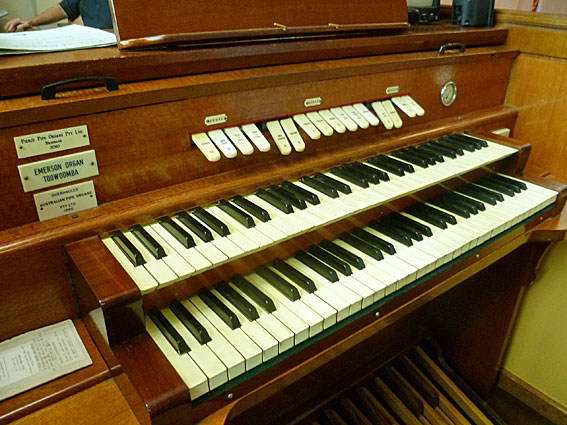
The console following additions in 1990 and 2010
[Photograph by David Vann (November 2012)]
The organ was enlarged to three manuals in 2014 by W.J. Simon Pierce of Brisbane, using the Swell pipework and slider soundboard from the 1904 George Fincham and Son organ removed in the 1990s from the Grahame Memorial Uniting (Presbyterian) Church, Waverley, New South Wales. The former 'Swell Organ' (unenclosed) became the Choir Organ. At the same time, a secondhand Flute 4' (1914, Rest Cartwright, London, originating from Suva Cathedral, Fiji) was added to the Choir Organ and the original Gemshorn 4' was revoiced at 2' pitch. A new three-manual draw-stop console of Tasmanian oak was supplied, and the casework repositioned to the gallery rail.11 The original Swell Cornopean 8' stop from Waverley,12 which has gone to the Apostolic Cathedral, Hatton Vale, has been replaced by a second-hand Trumpet 8' of American provenance.13
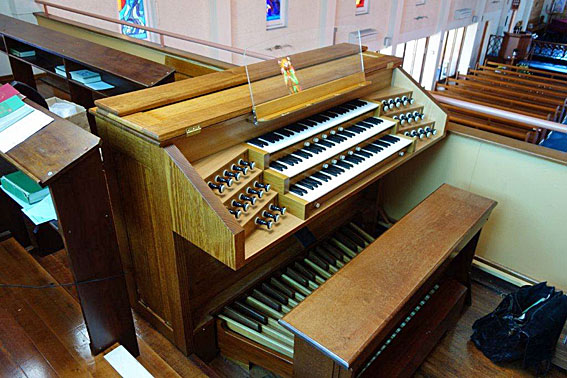
Detached draw-stop console supplied by W.J. Simon Pierce in 2014
[Photograph by David Vann (May 2014)]
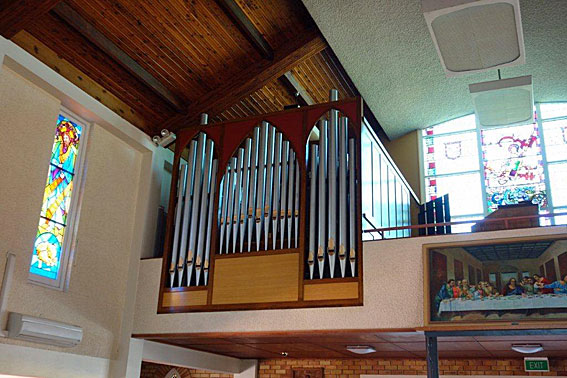
Casework repositioned to the gallery rail
[Photograph by David Vann (May 2014)]
The current specification is:
| GREAT Open Diapason Dulciana Principal Fifteenth Mixture (19.22) SWELL Open Diapason Gamba Gedact Principal Piccolo Oboe Trumpet CHOIR Rohr Flute Flute Gemshorn Larigot PEDAL Bourdon Bass Flute COUPLERS Great to Pedal Swell to Pedal Choir to Pedal Swell to Great Swell to Choir Choir to Great Choir Super Octave Swell Super Octave Swell Sub Octave |
8 8 4 2 II 8 8 8 4 2 8 8 8 4 2 1-1/3 16 8 |
A A |
[new bass from Tenor F, 1976] [1990] [2014; Fincham, 1904 'Violin Diapason'] [2014; Fincham, 1904] [2014; Fincham, 1904] [2014; Fincham, 1904] [2014; Fincham, 1904] [2014; Fincham, 1904] [2014; secondhand from America] [new bass octave, 1976] [2014; Rest Cartwright, London, 1914, ex Suva Cathedral, Fiji] [formerly 4'; revoiced 2014] [1982; Sifflute 1-1/3'] [2010] [2014] [1990] [2014] [2014] [1990] [2014] [2014] |
Detached draw-stop console [2014; formerly stop-key console]
Swell Tremulant
5 combination pistons to Great
5 combination pistons to Swell
Compass: 61/30
Electro-pneumatic action.14
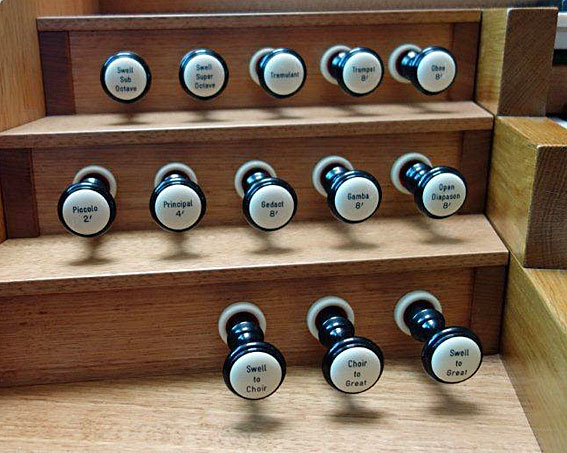
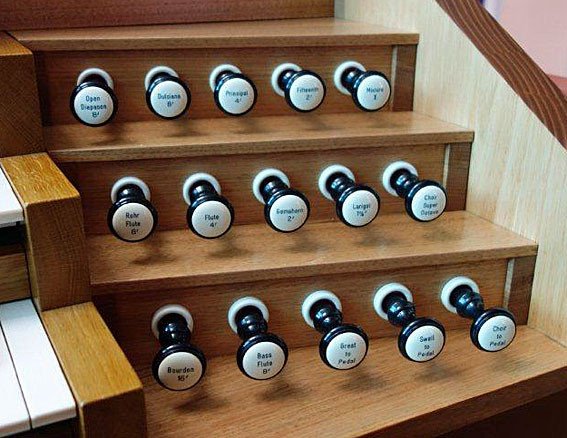
Console details following the 2014 enlargement
[Photographs by David Vann (May 2014)]
If, as seems likely, the original organ came from St Stephen's Presbyterian Church, Ipswich, it was one of the earliest organs in Queensland. Of the original organ, however, only the original pipework (which is of English origin) and possibly the Pedal windchest remain. The case is of Silky Oak, a timber commonly used in Queensland furniture.15
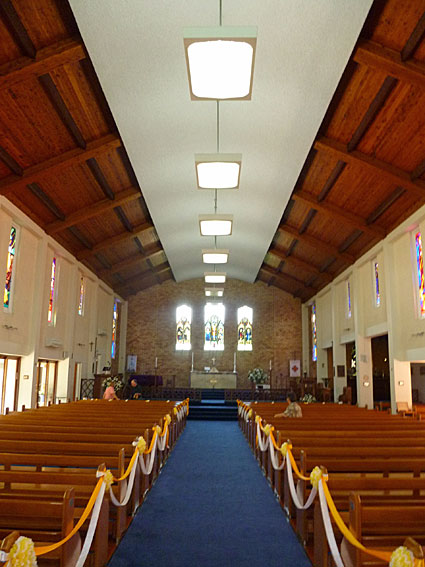
The interior of St Peter's Church
[Photograph by David Vann (November 2012)]
______________________________________________________________________________
1 Anglican Records and Archive Centre Guide to Records (DioceseofBrisbaneWeb, 2001) - accessed September 2011.
2 Donald Watson & Judith McKay, Queensland Architects of the 19th Century: A Biographical Dictionary (Brisbane: Queensland Museum, 1994), p. 15.
3 Personal communication to G. Cox from Robert Moore (Director of Music, The Southport School), September 1974. Bursary records for the period 1920-26 were reportedly unavailable at this time.
4 Personal communication to G. Cox from Grace Wilkinson (Organist), May 1974.
5 Specification noted by G. Cox, May 1974.
6 Personal communicatiuon to G. Cox from Walter Emerson, May 1975 and February 1976; and from Grace Wilkinson, December 1976. Specification noted by G. Cox, 1977 and 1985.
7 Personal communication to G. Cox from Robert Heatley, October 1990.
8 Loc. cit.; Organ Society of Queensland Newsletter, vol. 18, no. 1 (August 1990), p. 56.
9 The Organ Voice, vol. 24, no. 1 (March 1998), p. 30.
10 David Vann, 'The Organ of St Peter's Anglican Church, Southport, Gold Coast, QLD,' Organ Australia, vol. 6, no. 4 (December 2010), p. 40.
11 Details of 2014 additions supplied by Simon Pierce to John Maidment, March 2014, and Geoffrey Cox, January 2016; See also: 'From the Organ Builders,' Organ Australia (Winter 2014), p. 32.
12 Graeme Rushworth, Historic Organs of New South Wales: The Instruments, Their Makers and Players, 1791-1940 (Sydney: Hale & Iremonger, 1988), p. 184.
13 Personal communication to G. Cox from John Maidment, March 2014.
14 Specification noted by G. Cox, 1977 and 1985; subsequent changes as noted above, and from photographs by David Vann (2014).
15 Personal communication to G. Cox from Robert Heatley, October 1990.